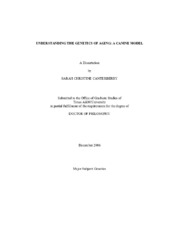| dc.description.abstract | As life expectancy in the United States increases each year, the percentage of the
population that is comprised of aged individuals rises also. Researchers expect the
largest increase in population to occur in the segment consisting of individuals 85 and
older. Thus, investigations of the aging process, with the goals of further extending
average life expectancy and improving the quality of life for aged individuals, have
become increasingly important to our society.
To better understand the genetics of aging, we elected to utilize another model
organism, the domestic dog. The benefit to this work is that breeds exhibit extreme,
natural variation in life expectancies. Here I report my contributions towards
establishing the dog as another model organism for investigations of the aging process.
Multiple linear regression analysis was carried out to determine the association
between life spans and breed size in the dog, based upon data derived from the American
pet population. A negative correlation was observed between both height and longevity
and between weight and longevity with weight being the significant predictor of life
span. Fifty-four genes implicated in the aging process were mapped to the canine
genome. These genes were selected because of their demonstrated contribution to
longevity in other organisms or based upon their proximity to a marker, D4S1564, on
human chromosome 4.
Four genes that are associated with dwarf mice and extended life span were
analyzed in nine dog breeds of varying sizes and life expectancies. Fifty-three
polymorphisms were discovered in Ghr, Ghrhr, Pit1, and Prop1. Thirteen ancestral
SNPs were discovered in which both alleles were found in every breed. In Ghrhr, a
transition mutation was found that changes the amino acid sequence as well as the
function of the protein and is statistically significant (p=4.8 x 10-6) when large dogs are
compared to medium-sized breeds, but not when they are compared to small breeds
(p=0.001). This SNP warrants further investigation in additional dogs and breeds. | en |


